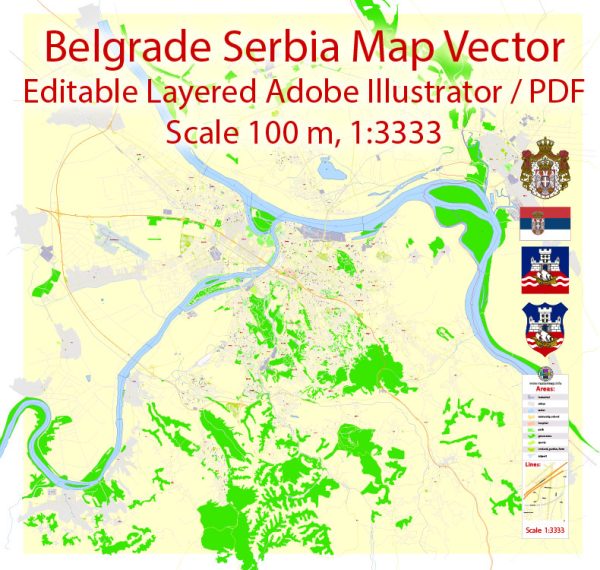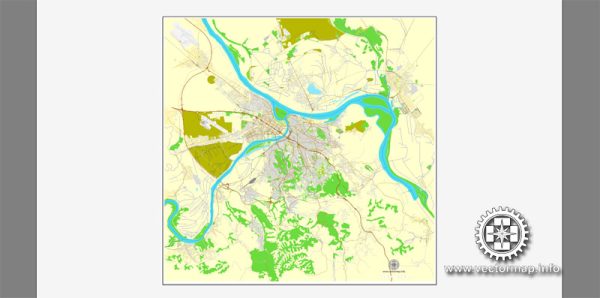Belgrade, the capital of Serbia, has a rich political and economic history that reflects the complex dynamics of the region. The history of Belgrade is closely tied to the broader history of the Balkans and the various empires that have influenced the region over the centuries.
Vectormap.Net provide you with the most accurate and up-to-date vector maps in Adobe Illustrator, PDF and other formats, designed for editing and printing. Please read the vector map descriptions carefully.
Here is a brief overview:
Ancient and Medieval Periods:
- Celtic and Roman Influence (3rd century BC – 5th century AD): The area that is now Belgrade has been inhabited since ancient times. Celts settled in the region in the 3rd century BC, and later, the Romans conquered the area and established the city of Singidunum. It became an important military and economic center.
- Byzantine and Slavic Influence (5th century – 12th century): With the fall of the Western Roman Empire, the region came under Byzantine control. In the 7th century, Slavic tribes settled in the area, contributing to the ethnogenesis of the Serbian people. Belgrade was later part of the medieval Serbian state.
Ottoman Period (15th century – 19th century):
- Ottoman Conquest (15th century): The Ottoman Empire conquered Belgrade in 1521, marking the beginning of almost four centuries of Ottoman rule. Belgrade became a significant administrative and military center within the Ottoman Empire.
- Habsburg-Ottoman Wars: Belgrade changed hands multiple times between the Ottoman Empire and the Habsburg Monarchy during the Habsburg-Ottoman Wars.
19th and Early 20th Centuries:
- Independence and Modernization (19th century): Serbia gained its independence from the Ottoman Empire in 1878. Belgrade became the capital of the independent Kingdom of Serbia. The city experienced significant modernization and urban development during this period.
- World Wars: Belgrade was heavily affected during both World Wars. In World War I, it was occupied by Central Powers, and in World War II, it was bombed by the Axis powers.
Socialist Yugoslavia (1945 – 1992):
- Formation of Yugoslavia: After World War II, Yugoslavia emerged as a socialist federation under Josip Broz Tito. Belgrade became the capital of the Socialist Federal Republic of Yugoslavia (SFRY).
- Economic and Political Developments: Under Tito’s leadership, Yugoslavia pursued a unique form of socialism, independent from the Soviet Union. The country experienced relative economic prosperity, and Belgrade became a cultural and economic hub.
Post-Socialist Era (1992 – Present):
- Breakup of Yugoslavia: The disintegration of Yugoslavia in the early 1990s resulted in the formation of the Federal Republic of Yugoslavia, which later became the State Union of Serbia and Montenegro and eventually separated into independent states.
- Political Changes: Serbia went through significant political changes in the post-socialist era, with a shift from socialist rule to a multiparty democracy. Belgrade has been at the center of these political transformations.
- Economic Challenges and Transition: The breakup of Yugoslavia and the wars in the region had a profound impact on the economy. Serbia underwent economic reforms and transition to a market-oriented system, facing challenges such as hyperinflation and unemployment.
- European Integration: Serbia has expressed aspirations for European Union (EU) membership. Belgrade plays a crucial role in the country’s efforts toward European integration, economic development, and political stability.
Recent Years:
- Kosovo Issue: The status of Kosovo remains a sensitive and complex issue, affecting Serbia’s foreign relations. The normalization of relations between Serbia and Kosovo is a key factor in the region’s stability.
- Economic Progress: In recent years, Serbia has seen economic growth and increased foreign investment. Belgrade, as the capital, has been a focal point for infrastructure development and economic activities.
In summary, Belgrade’s political and economic history is deeply intertwined with the broader historical developments in the Balkans, from ancient times to the present day. The city has experienced shifts in political regimes, wars, and economic transformations, shaping its current status as the capital of the Republic of Serbia.



 Author: Kirill Shrayber, Ph.D.
Author: Kirill Shrayber, Ph.D.